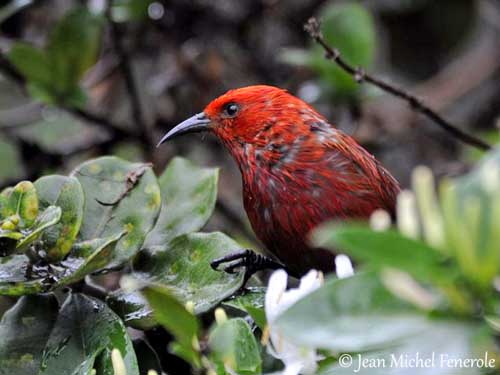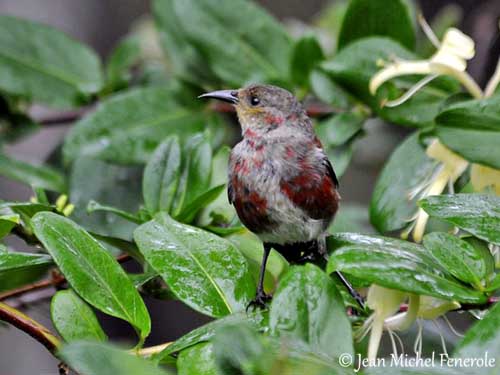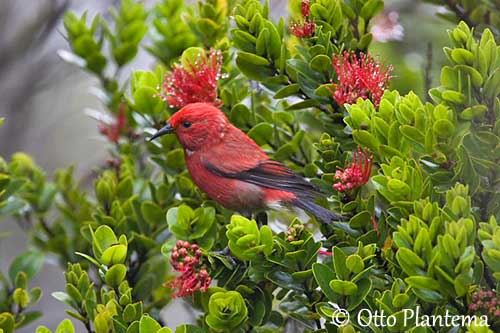
Fr: Picchion cramoisi
Nd: Apapane
Photographers:
Jean Michel Fenerole
Photos d’Oiseaux du monde
Otto Plantema
Trips around the world
Text by Nicole Bouglouan
Sources:
HANDBOOK OF THE BIRDS OF THE WORLD Vol 15 by Josep del Hoyo-Andrew Elliot-David Christie - Lynx Edicions – ISBN: 9788496553682
BirdLife International (BirdLife International)
Wikipedia, la enciclopedia libre
What Bird-The ultimate Bird Guide (Mitchell Waite)
Maui Forest Bird Recovery Project
Apapane
Himatione sanguinea
Passeriformes Order – Fringillidae Family
INTRODUCTION:
The Apapane is a thin-billed nectarivore within the group of the Hawaiian honeycreepers. This species is endemic to Hawaii. Formerly included in the family Drepanididae, this group is now added to the Fringillidae family.
The Apapane has more down-curved than tickle-shaped bill, allowing the bird to take nectar from numerous flowers, and mainly from its favourite plant ohia-lehua (Metrosideros polymorpha).
DESCRIPTION OF THE BIRD:
Biometrics:
Length: 13 cm
Weight: M: 16 gr – F: 14,5 g
The adult has bright crimson-red plumage, on head and body, including shoulders and upperwing-coverts. Flight-feathers are black, but tertials are edged crimson. The tail is black.
On the underparts, belly and rear flanks are grey, whereas undertail-coverts are white.
The down-curved bill is black. The tongue is brush-tipped, very useful to get nectar from flowers. The eyes are dark brown. Legs and feet are black.

BEHAVIOUR IN THE WILD:
The Apapane feeds primarily on nectar from ohia-lehua flowers. It is an important pollinator for this plant species. It also gleans insects from flowers and foliage while feeding on nectar.
It also takes nectar from a wide variety of native trees and shrubs and from introduced flowers too. Insects taken include grasshoppers, caterpillars and various bugs.
The Apapane can be seen perched conspicuously outside the canopy, moving fast among the dense foliage. It usually feeds alone or in loose flocks.
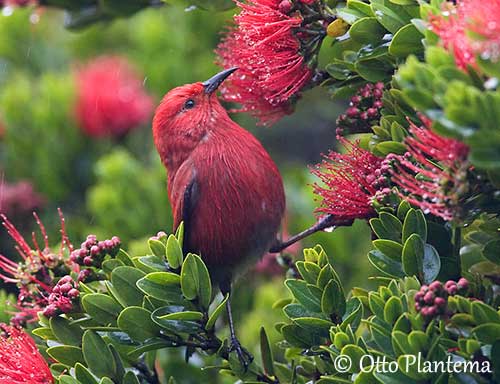
REPRODUCTION OF THIS SPECIES:
The breeding season may extend from December to July, and two clutches are usually produced.
Both sexes build the nest, usually in leaf cluster at top of ohia-lehua trees, but also sometimes in tree ferns, or tree cavities, and even in lava-tubes.
The nest is made with moss, lichens, rootlets, bark, twigs and leaves. The inner cup is lined with soft grass and plant fibres.
The female lays 1-4 white eggs with brownish markings. She incubates alone during 13 days. Both sexes feed the chicks but mainly the female. The nest is regularly cleaned throughout the cycle.
The young leave the nest about two weeks after hatching, but they remain in family group during some months.

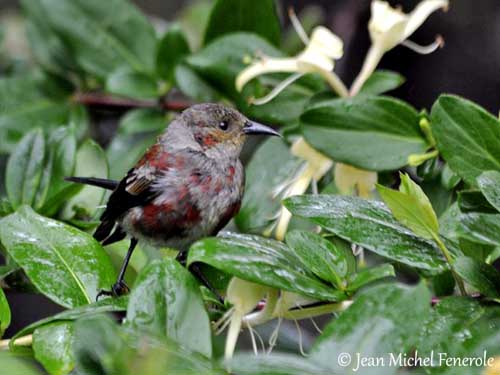
RANGE:
The Apapane is found on Hawaiian Islands, Kauai, Oahu, Lanai, Molokai, Maui and Hawaii.
HABITAT:
The Apapane is restricted to native forest habitat at high elevation, up to 1000 metres.
CALLS AND SONGS: SOUNDS BY XENO-CANTO
The Apapane utters loud “tewp” and “teerp” in flight.
The song is highly variable, loud and long, including a combination of trills, whistles, squeaky and clicking sounds.
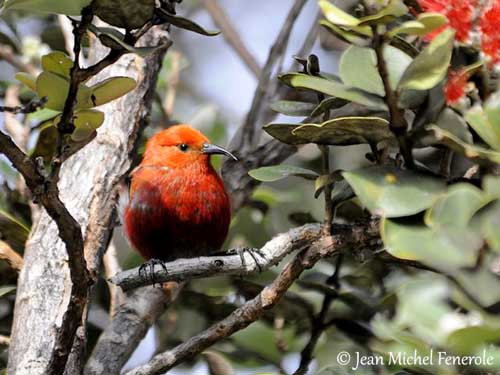
During the breeding season, it performs courtship displays. The male sings while hopping from branch to branch. The tail is cocked, in order to display the white undertail-coverts contrasting strongly with the black rectrices.
It also sings while the female incubates. It remains perched in the vicinity of the nest and sings. Its loud song chases away the rivals from the nest-site. Both sexes defend a small territory around the nest.
The male also performs courtship feeding to the female during nest-building and incubation. They are monogamous.
The Apapane is resident in its range, but it wanders to find food sources, and mainly nectar. Daily flights to lowland feeding areas are common, sometimes over quite long distances.
The flight is direct and undulating, with rapid wingbeats interspersed with wings pulled to body sides. Its flight produces a characteristic whirring sound.
